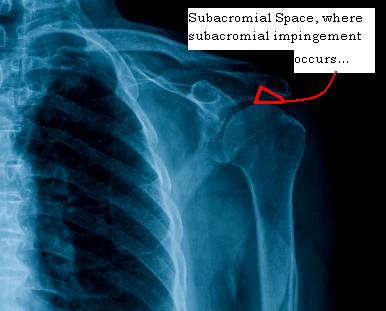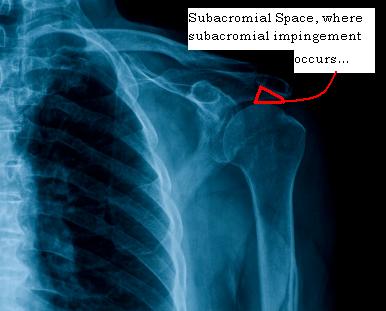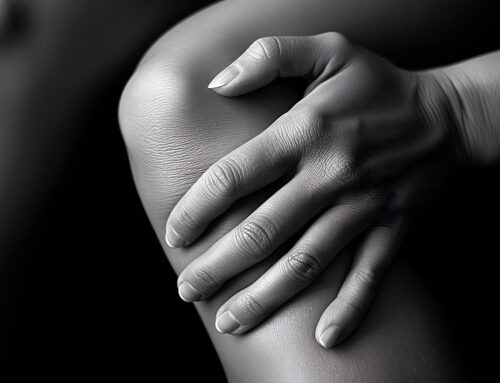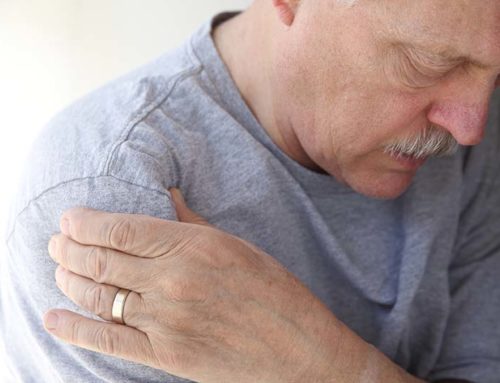Shoulder Impingement – Specific Causes
It’s always easier to understand a condition when we simplify it. This happens quite often in the world of physical rehabilitation. An example in the knee would be the diagnosis of patellofemoral syndrome. This is a term that many practitioners use to describe a patients knee pain, yet it doesn’t specifically distinguish between various causes of pain in this area. Quite often patients are diagnosed with a condition in the shoulder called impingement. Again, this is helpful for some patients so that they can understand their condition better, but it is still a very vague term.
Shoulder Impingement Causes
Impingement of the shoulder is much like the name implies; certain structures get pinched which causes pain. This is obviously a very simple explanation of a very complex topic. There are various different types and different causes of impingement in the shoulder. For the practitioners out there, we know there is internal and external impingement. Internal impingement involves compression of tendons (usually) between the head of the humerus and the glenoid labrum. External impingement involves compression of the rotator cuff tendons or the subacromial bursa between the humeral head and the acromion process.
Functional Shoulder Impingement
At this point I’ve probably already confused the average reader, so the rest of this blog will focus on something more interesting; the various causes of secondary or “functional” impingement. This category of impingement is somewhat fixable in a clinical setting with the help of a manual practitioner.
Decreased Shoulder Movement
For some people, their shoulder impingement is associated with a loss of movement in the shoulder. Specifically, it would be a loss of internal rotation (turning your arm inward). This is something we can detect clinically and can give us clues to various dysfunctions in a patients shoulder. Among other things, this loss of movement alters the axis of motion in the shoulder which can lead to impingement.
Altered Shoulder Blade Movement
The scapula (shoulder blade) can move in a sub-optimal pattern leading to impingement of the shoulder. Termed scapular dyskinesis, the altered movement has a cascading effect on various shoulder tissues. Scapular dyskinesis has various causes and types, but the take-home point is that it can eventually lead to internal impingement in the shoulder.
Rotator Cuff Dysfunction
The various rotator cuff muscles have different prime movements. Together they can serve to depress or hold the humeral head down during abduction. When there is dysfunction in the rotator cuff muscles you can lose this ability and the humerus can translate upwards (resulting in impingement). Of note, rotator cuff injury can also lead to external impingement.
SLAP Lesion
A SLAP lesion refers to damage in the cartilaginous labrum of the shoulder. The labrum lies directly against the head of the humerus, so damage in this area can “get in the way” when we move the shoulder.
Shoulder Instability
Some people have too much laxity in their shoulders. This can be from repeated trauma or can simply be the way they are “built”. In this case, the patient’s humerus translates upwards and compresses various tissues (which is impingement).
Treatment for Shoulder Impingement
In an effort to be more specific and delineate the various causes of shoulder impingement this blog may actually confuse many readers. The take-home point is that sometimes your practitioner may simplify things so you understand them easier. Impingement of the shoulder can be a very complex condition with various causes. Due to this, there are various different ways to properly fix it. For some people, manual treatment and the use of therapeutic modalities are necessary. For others, specific exercises and rehabilitation strategies are indicated. Active Release Technique, Graston and Laser Therapy are all common methods for treating shoulder pain. Unsure what to do? Give us a call!
To contact our Burlington clinic – [email protected]
References
Cools AM, Cambier D, Witvrouw EE. Screening the athletes shoulder for impingement symptoms: a clinical reasoning algorithm for early detection of shoulder pathology. British Journal of Sports Medicine 2008; 42: 628-635.
Tate AR, McClure P, Kareha S, Irwin D. Effect of the scapula reposition test on shoulder impingement symptoms and elevation strength in overhead athletes. Journal of Orthopaedic & Sports Physical Therapy 2008; 38(1): 4-11.
Disclaimer https://burlingtonsportstherapy.com/blog/disclaimer/









